
Storage Systems & Types
The term “Storage” refers to the physical act of storing the materials or stock in a warehouse, on pallets, shelves, racks, boxes, bins etc. with the objective of retrieving them later for issue or dispatch to the customer or internally. Warehouses have secured spaces where inventory is stored before shipping it out to the end customers. A warehouse gives better control over the inventory and ensures that customers receive on-time delivery of products, ultimately leading to higher profits.
Warehouses may employ either one or a combination of different types of warehouse storage systems. Depending on the system’s efficiency, warehouses can greatly improve the order fulfillment and picking processes. An organized storage system is also the key to promoting a safer workplace environment. It helps in avoiding any potential hazards that may endanger warehouse employees as they handle heavy machinery and move about the warehouse.
What is a warehouse storage system?
A warehouse storage system is a set of physical structures used to store goods in an organized and efficient manner. It helps businesses optimize their space, improve inventory management, and streamline order fulfillment. Warehouse storage systems come in a variety of types, each with its own advantages and disadvantages.
Warehouse storage solutions play a crucial role in the success of any business that handles physical goods. They provide a structured and organized approach to storing inventory, ensuring that products are easily accessible, protected from damage, and efficiently managed.
Objectives of Storage
The main objectives of storage are:
- Maximum Utilization of Space
- Accurate identification of the materials stored
- Ease of storing and picking
- Protection of the materials
Warehouse Storage Methods
Warehouse storage methods are the strategies and techniques used to organize, store, and manage inventory within a warehouse facility. Effective warehouse storage methods are crucial for optimizing space utilization, enhancing inventory management, and streamlining order fulfillment processes.

Loose

Binned Storage

Block Stacking
The materials, usually in containers are stacked on top of one another till a maximum safe height.

Shelving

Racking
This is often used to store palletized goods. One pallet is stored on the stacking side of the rack. If forklifts are used racks can go up to 30 feet and if overhead stacker cranes are used, racks can even go up to 60 feet.
Types of warehouse Storage Equipments
Warehouse storage equipment is an essential component of any warehouse operation, enabling efficient storage, organization, and retrieval of inventory. The type of equipment used depends on the specific needs of the warehouse, such as the type of products being stored, the volume of inventory, and the desired level of automation.
Some of the types of warehouse storage equipment generally used are –
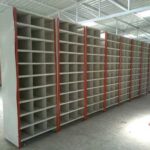
Concrete Pigeonholes
These are used for bulk storage of heavy items, particularly in the receiving section. This method is used for storing paper items, bulky packages etc. The pigeonhole sizes may vary from 2’x2’x2’ to 4’x4’x4’.

Wooden Shelves
These can be built to various sizes. They are normally cheap and light in weight. However, they are not durable.
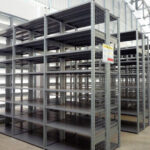
Steel Shelves (Closed or Open)
These are widely used, can be built to any required dimension and are durable. There is complete flexibility, interchangeability and adaptability.
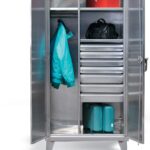
Steel Cupboards
These are used for keeping expensive or attractive materials.
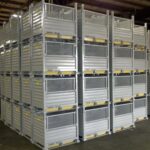
Steel Bins
A bin is a compartment or pigeonhole that is fitted with a bin front. Different sizes are available and are used for storing hardware items, ball bearings, metal parts etc. Bins give protection to materials from dust and dirt.

Slotted Angle Shelves
Some racks have slotted angles. The angles have holes all along their length, and the shelves can be fixed at any point desired, truly providing flexibility to the gap between two shelves. The cross members can be changed to a different position. Flexibility and durability are the characteristics of these types of shelves.
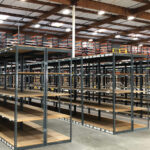
Boltless Shelves
This is a slight variation of slotted angle shelves. Here, instead of holes that enable two bars to be bolted together, there are pockets into which a short bolt can slide into the upper bar. Such shelves are used generally for heavy parts and can be erected to a tall height.

Light duty cantilever shelving
Shelving is supported on steel cantilever arms, which pass through central steel uprights. Shelf levels are adjustable.

Long span adjustable shelving
These are designed to meet span requirements exceeding 900mm and load up to 500kg per shelf.

Mobile storage bins
The racks or bins themselves are made to move. Usually, the bins move upon fixed rails. In some cases, bins are capable of free movement. One end of the rack is mounted on wheels and the opposite end is on stands. The end with the stands is hooked to a forklift truck.

Tote Pans
These are unit containers. They not only provide an improved storage factor, but also facilitate counting, dispensing, handling, checking and issue.
Warehouse Racking
Warehouse racking is a type of storage system used to organize and store goods within a warehouse facility. It is a crucial component of warehouse operations, as it enables efficient storage, organization, and retrieval of inventory. Warehouse racking systems come in various types and configurations to suit different product types, storage capacity requirements, and warehouse layouts design. Warehouse storage racks are essential components in optimizing warehouse space and facilitating efficient inventory management.

Racking
Racks are of two types – racks for string raw materials such as sheets, bars, sections, or rolls of materials; and racks for storing unit storage equipment, including pallets, tore pans etc.

Roll-through Racking
Racks are filled with rollers on which the goods rest. The goods enter through one face of the rack and then exit from the opposite side, which is inclined with respect to the stacking face.

Drive-through Racking
Goods are stored in depth in high racks up to 30 feet and the forklift can go through the racks and pick up pallets from where they are stored at heights.

Mobile Racking
Racks are mounted on rollers and are moved to make way for a particular rack to be operated.
Tackle Space Challenges to Optimize Your Warehouse
Advantages of Storage Equipment
The right storage system within the warehouse can truly make a world of difference. However big or small the warehouse, if it is unorganized it will directly affect productivity. A smart and efficient storage system will not only organize the current inventory but it will also make space for new inventory.
- Safety: Due to the kind of work being performed and the weight of all the products involved, warehouses can naturally be dangerous environments. However, with a cluttered warehouse, safety risks can increase tenfold. The safety of employees, inventory, tools, and machines, should always be a top priority. An organized warehouse is a safer warehouse. With an organized system, the products or goods have designated places, that way they stay safe and well protected.
- Efficiency and Productivity: A good inventory management strategy is backed by an organized warehouse. If the warehouse is cluttered or disorganized, managing inventory becomes tough. Inventory should be stored in a way that not only allows one to make the most of available space but also assembles it in a neat and efficient way. This ensures that inventory can be located and retrieved in a quick and efficient manner. This, in turn, helps speed up the order fulfilment process and keeps customers happy.
- Saves Time and Money: A warehouse that is organized will improve the accuracy of inventory orders. A well-kept storage facility helps figure out exactly how much inventory is needed to have on hand. This will let not only prevent product shortages but also allow storing just enough inventory without keeping any excess in the warehouse. When inventory is neatly displayed, the effort of having to do an inventory recount to ensure records are accurate is eliminated.
- Optimizing the Space Available: Businesses are always on the lookout for space to store new inventory. One of the biggest benefits of investing in a modern and comprehensive storage system is that it maximizes the utility of the available space in the warehouse for inventory storage. Reinventing an existing warehouse system turns out to be a lot easier and more cost-effective than acquiring a new warehouse or office altogether.
A cluttered or disorganized warehouse means setting the business up for potential inventory errors and challenges.
Optimize Your Warehouse Storage with Pyrops WMS
Pyrops WMS is the key to efficient space utilization as it optimizes warehouse layouts, streamlines inventory processes, and enhances pick-and-pack operations, maximizing every inch of storage space. With real-time insights and automated workflows, Pyrops ensures a seamless, organized, and productive warehouse environment.
At Pyrops WMS, we are committed to providing comprehensive warehouse storage solutions tailored to your specific requirements. Our team of experts will work closely with you to assess your needs and recommend the most effective storage solutions for your business.

|
|
Thank you for Signing Up |









